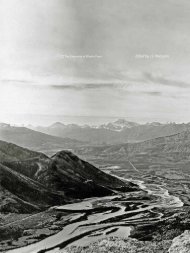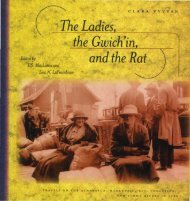Paul Kane's Journal of his Western Travels, 1846-1848 - History and ...
Paul Kane's Journal of his Western Travels, 1846-1848 - History and ...
Paul Kane's Journal of his Western Travels, 1846-1848 - History and ...
You also want an ePaper? Increase the reach of your titles
YUMPU automatically turns print PDFs into web optimized ePapers that Google loves.
I<br />
rite t<strong>his</strong> part <strong>of</strong> my jurnal over a biasing fire on the shore <strong>of</strong> Lake Winapeg whare<br />
I have campt for the night," records <strong>Paul</strong> Kane on June 11, <strong>1846</strong>. The first<br />
pr<strong>of</strong>essional artist to travel the northern fur-trade route from the Great Lakes to the<br />
Pacific Ocean, Kane endured almost unbelievable hardships, experienced<br />
extraordinary adventures, <strong>and</strong> witnessed astounding scenery. He also painted some<br />
remarkably telling portraits <strong>of</strong> the Native Americans he encountered <strong>and</strong> whose<br />
respect he earned.<br />
For two years, through snow <strong>and</strong> ice, rocks <strong>and</strong> rapids, searing heat <strong>and</strong> soaking<br />
rains, <strong>Paul</strong> Kane managed to keep ajournal. It survived, along with many <strong>of</strong> <strong>his</strong><br />
sketches, in the artist's family <strong>and</strong> is now one <strong>of</strong> the treasures <strong>of</strong> the Stark Museum <strong>of</strong><br />
Art, Orange, Texas. Those readers who know Kane through the book W<strong>and</strong>erings <strong>of</strong><br />
an Artist (1859) will find that <strong>his</strong> actual journal, which is being published here for the<br />
first time <strong>and</strong> in its original form, differs significantly from W<strong>and</strong>erings in many<br />
respects. What appears in the following pages is entirely <strong>Kane's</strong> own story, a vivid<br />
eyewitness account, reproduced as exactly as possible to the way he wrote it, line for<br />
line, eccentric spellings <strong>and</strong> all.<br />
The artist tells <strong>his</strong> experiences with humanity, simplicity, <strong>and</strong> humor. Some<br />
passages, in their frighteningly real descriptions <strong>of</strong> the extreme cold, bring to mind<br />
thoughts <strong>of</strong> Jack London. Other sections remind one <strong>of</strong> Mark Twain. On July 14,<br />
1847, Kane writes: "left at 5 t<strong>his</strong> morning for the river Nepersey <strong>and</strong> arrived at 12 a<br />
distance <strong>of</strong>30 m. no water all day. a good plase for a persion with the Hidr<strong>of</strong>oba t<strong>his</strong>."<br />
On November 18, a day after having fallen through ice <strong>and</strong> nearly drowning in the<br />
strong current, the artist discovers that <strong>his</strong> dog has gnawed its cord <strong>and</strong> deserted him<br />
in the night. Kane remarks wryly, with a sentiment we all know well, '"missfortians<br />
never com single."<br />
Just as <strong>Paul</strong> <strong>Kane's</strong> journey took him back <strong>and</strong> forth over the boundary <strong>of</strong> what<br />
was to become the United States <strong>and</strong> Canada, so, too, has t<strong>his</strong> special issue <strong>of</strong> THE<br />
AMERICAN ART JOURNAL crossed international borders. It was at the 1987 meeting <strong>of</strong><br />
the American Studies Association, held in New York, the first joint conference with<br />
the Canadian Association for American Studies, that I met Ian MacLaren <strong>of</strong><br />
Edmonton, Alberta, <strong>and</strong> learned <strong>of</strong> <strong>his</strong> fascinating work on <strong>Paul</strong> Kane, an artist <strong>of</strong> just<br />
as much interest to Americans as he is to Canadians. Once upon a time, before the<br />
great interior <strong>of</strong> the continent had been mapped <strong>and</strong> the dotted lines had been put<br />
down, Native Americans could pursue their lives relatively unencumbered by<br />
artificial boundaries. Now, at long last, such lines on a chart <strong>and</strong> the obstacles they<br />
have created are less <strong>and</strong> less <strong>of</strong> an impediment to those who study <strong>and</strong> publish the<br />
culture <strong>of</strong> North America.<br />
We are deeply grateful to Nelda C. Stark for kindly granting permission to<br />
publish <strong>Paul</strong> <strong>Kane's</strong> journal in its entirety <strong>and</strong> to the staff <strong>of</strong> the Stark Museum <strong>of</strong> Art<br />
for their extraordinary help <strong>and</strong> cooperation, so cheerfully given.<br />
J. T.
















